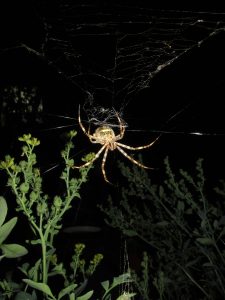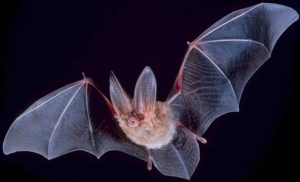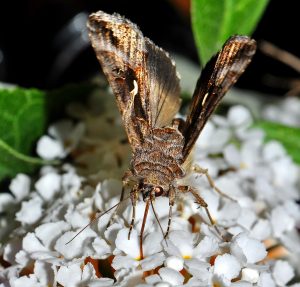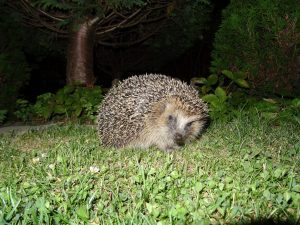Green gardening around the clock
If you have a garden, and if you care for the environment, you have probably planted native flowers, created hiding places for all sorts of critters, don’t use pesticides, and much more. There are many thing we can do to create a little but valuable refuge in our backyard, and the number of environmentally aware people is growing. At least during the day. Because sometimes – quite often actually – when I look at a garden at night, there are some things that shouldn’t be done when you care for the environment. Things, many people don’t think or know about. Yes, I am talking about lights.
No question, lights in a garden can be beautiful. I love sitting out there with a few candles or fairy lights. However, even garden lights contribute to light pollution, even if only in your little personal spot. Here is why:
Light attracts and scares away

You know that moment. You turn on the light, settle down on your porch, and the insects come. Most of them are moths, whose job actually isn’t to disturb your quiet evening, but to pollinate the plants in your garden. Unfortunately, the light on your porch is more attractive than the plants, so the moths don’t do their job. Some will die at your light. Others will be caught by a smart spider.
Some spiders have learnt to use artificial light to get more catches. The Australian garden orb-web spider grows much faster with dim light at night and starts to reproduce at an earlier age. However, these spiders were also smaller, produced less eggs and lost more of their offsprings. What seemed an advantage might, in the long run, not be so good for the spiders.
Not all spiders make nets, some hunt on the ground, and some of those species also hunt underneath the lights, together with some scavenging beetles. This is good for them, because down there are lots of bodies of insects that have burnt to death in the heat of the lights. Good for some species, but other species of spiders and beetles avoid the light and miss out on all the food that gathers around the lights.
Another species who is drawn to the light are roundback-slugs – although nobody knows why, because they usually avoid light at night. However, scientist found a higher number of slugs around solar garden lights during the day, though not during the night. It’s possible that they fed from dead insects or plant material (some plants grow larger when illuminated).
Not a very good idea is to illuminate trees and bushes. One reason is that pointing a light beam into the sky adds to skyglow, the other is that these bushes actually are the bedroom of some animals. Pointing light at them disturbs their sleep. It has been shown in tit-mice that they stay up longer in the evening, start their days earlier, and thus get less sleep.
Many small nocturnal animals avoid illuminated areas, probably because they are more at danger from predators. Also, most nocturnal animals have very sensitive eyes, so the light blinds them, especially if it is on eye-level. We know that frogs avoid bright areas, but if they are caught in the light, they won’t leave because their eyes are adjusted to the light. If they would hop into the darkness, they would be blind to any danger.
Bats love the light, don’t they?

One mammal group that desperately needs our help are bats. You might have seen bats hunt in the light, so some people think might be a good idea to switch on a spotlight for the little mammals. Indeed, some species like
noctule bats, pipistrelles and house bats use the light as fly-through to catch insects. However, slow-flying bats like mouse-eared bats avoid the light. They need to feed on the small number of insects that is not drawn into the light.
No matter if a bat hunts in the light or not, they all want to sleep in the dark. If light shines at a bat box or the entrance to a possible bat roost, bats won’t use it. They even leave roosts when light is installed. Since our cities, villages, and churches become constantly brighter, dark gardens are an invaluable refuge for bats.

Another way to help bats is by planting nocturnal plants. Never heard of nocturnal plants? Well, some plants produce nectar only during the night to attract nocturnal insects or – if you’re in the tropics – bats. Check what nocturnal plants are available in your area. Aside of providing food for insects and bats, they will embellish your garden with nightly flowers and scents.
Light also influences plants
Talking about plants – they will probably be the most obvious feature in your garden, so think about their well-being too. Surprisingly, not much is known about the effect of nocturnal illumination on plants. From greenhouses, we know that elongated days can increase fruit production and flowering in some plants, but it can have the different effect in other plants. Something you can observe yourself is that plants next to a street light will produce buds earlier in spring and keep their leaves longer, which makes them more vulnerable to frost. One study even found signs of burn-out in street trees, when they use the light for photosynthesis at night. And, last but not least, plants sleep too. If you shine a light onto them at night, it might interfere with their sleep too.
Here the circle to the insects completes itself. Plants underneath lights get fewer visits from insects. This results in less pollination and smaller or fewer fruits. So it’s good advice not to illuminate your vegetable patch or orchard.
One last word on solar lights. Solar power has many ecological advantages, but that doesn’t make solar lights necessarily environmentally friendly. The production of solar cells and batteries uses rare earths, their disposal is also problematic. Cheap solar lights usually last only few years before they have to be disposed as electronic scrap. So far, the only way to dispose LEDs is to store them, recycling doesn’t work yet. This means that these solar lights might be pretty, but they also harm our environment.
How to have a night-friendly garden:
So what can you do for an environmentally and night-friendly garden illumnation?
Use lights only when you look at them. Switch them off when you leave or use timers to make sure that you don’t forget them. Honestly, nobody will admire your garden at 3 am.
Use less to gain more. Only use few lights with low intensity. Start with one light and add one at a time until it’s bright enough. Lights you buy at the shop are usually way too bright. By the way, light design has gained a new discipline: darkness design. Designers use less light and work with contrasts to keep the mystery of the night.
Point lights downwards. Use shielded lights and point them to the spots that need light. This will also protect you from glare. Stay away from skybeamers (they don’t work for a long time anyway and you can’t see most of the light because it disappears into the sky) and do not illuminate trees.
Use warm light. Cold-white light might be more energy-efficient than warm-white or amber, but what you might win in CO2-savings, you pay with other ecological damage. Light above 3000 Kelvin influences the biological rhythms of humans and animals, is more attractive to insects and produces more glare.
The best advice is: Don’t illuminate your garden! Light installations can be beautiful, but they are never environmentally friendly.
Scientific studies:
Grunsven et al. 2018. Slugs (Arionidae) benefit from nocturnal artificial illumination. Journal of Experimental Biology 329 (8-9):429-433
Knop et al. 2017. Artificial light at night as a new threat to pollination. Nature 548: 206-209
Kwak et al. 2018. Night Light-Adaptation Strategies for Photosynthetic Apparatus in Yellow-Poplar (Liriodendron tulipifera L.) Exposed to Artificial Night Lighting. Forests 9(2): 74.
MacGregor et al. 2019. Effects of street lighting technologies on the success and quality of pollination in a nocturnally pollinated plant. Ecosphere 10(1): e02550
Puttonen et al. 2016. Quantification of Overnight Movement of Birch (Betula pendula) Branches and Foliage with Short Interval Terrestrial Laser Scanning. Frontiers in Plant Science 7: 4-6
Raap et al. 2017. Disruptive effects of light pollution on sleep in free-living birds: Season and/or light intensity-dependent? Behavioural Processes 144: 13-19

